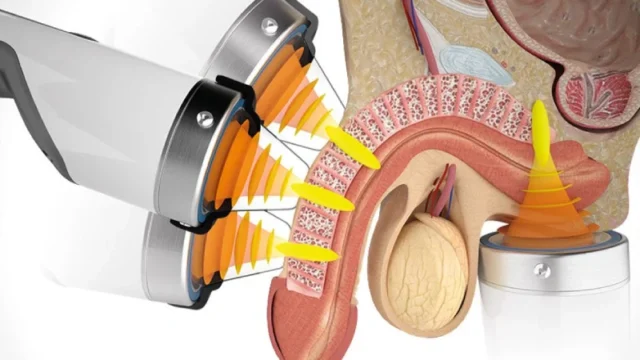In a world where appearance and performance matter, male enhancement has become a popular topic of conversation. Men are constantly seeking ways to enhance their confidence and improve their intimate experiences. From devices to surgeries, the latest trends in male enhancement offer a range of options to explore.
Gone are the days when men had limited choices. Today, innovative devices like traction extenders and vacuum pumps promise noticeable results. These non-invasive solutions aim to enhance length and girth, restoring confidence in the bedroom.
For those seeking a more permanent solution, surgical procedures such as penile implants have gained traction. These advanced medical procedures can provide lasting results for those willing to pursue a surgical route.
However, it is important to note that while these trends may be intriguing, it is vital to consult with medical professionals before embarking on any male enhancement journey. Each individual’s needs and requirements are unique, making professional advice essential for making informed decisions.
Join us as we delve into the latest trends in male enhancement. Discover the various options available, their effectiveness, and the considerations to keep in mind when exploring these avenues. Together, let’s explore the world of male enhancement and uncover the facts behind the trends.
Historical Perspective on Male Enhancement
The quest for male enhancement is not a modern phenomenon; it has roots that stretch back to ancient civilizations. Historical records reveal that cultures such as the Greeks, Romans, and Egyptians engaged in various practices aimed at improving male sexual performance and physical attributes. These early endeavors often involved the use of herbal remedies, potions, and even rituals aimed at enhancing virility. The ancient Greeks, for instance, believed in a link between physical prowess and male fertility, leading to the use of specific herbs like ginseng and various aphrodisiacs in their diets to boost libido and performance.
As time progressed, the Renaissance period marked a significant shift in the perception of male enhancement. This era saw a surge in anatomical studies and a burgeoning interest in human physiology. The exploration of the male body led to a more scientific understanding of sexual health, with some physicians advocating for treatments that ranged from dietary changes to more invasive procedures. By the 19th century, the advent of surgical techniques began to open new avenues for enhancement, although these methods were often rudimentary and fraught with risks.
In the late 20th century, societal attitudes towards male enhancement began to evolve dramatically, influenced by the sexual revolution and the rise of consumerism. More men began to openly seek solutions for enhancing their sexual experiences, leading to an explosion of products and services in the market. This period marked the transition from ancient remedies to modern devices and surgical options, laying the groundwork for the diverse range of male enhancement methods available today. The historical journey of male enhancement reflects not just changing perceptions of masculinity but also the ongoing influence of culture, science, and technology on men’s health and wellness.
Common Male Enhancement Methods
In the contemporary landscape of male enhancement, various methods have emerged, catering to different needs and preferences. The most common approaches can be categorized into three main types: devices, surgical procedures, and non-invasive treatments. Each method offers unique benefits and considerations, making it essential for individuals to carefully evaluate their options before embarking on a male enhancement journey.
Devices have gained significant popularity over the years, largely due to their non-invasive nature and the perception that they carry fewer risks compared to surgical options. Among these, vacuum pumps and traction devices are particularly well-known, as they promise to increase size and improve sexual performance through mechanical means. Vacuum pumps work by creating suction around the penis, promoting blood flow and potentially leading to temporary enhancement of size. Similarly, traction devices aim to elongate the penis through consistent stretching, appealing to those seeking a gradual and non-surgical solution.
On the other hand, surgical options, while more permanent, come with their own set of complexities. Procedures such as penile implants and lengthening surgeries can provide lasting results, but they also involve significant risks and recovery times. As a result, many men find themselves weighing the benefits of surgical enhancement against the potential complications. Additionally, non-invasive treatments such as oral supplements and topical creams have gained traction, appealing to those looking for simpler solutions. As the market continues to evolve, understanding these common methods is vital for making informed decisions about male enhancement.
The Rise of Devices in Male Enhancement
The rise of devices in the realm of male enhancement can be attributed to several factors, including advancements in technology, increased awareness of men’s health issues, and a growing acceptance of male enhancement as a legitimate concern. In recent years, a significant shift has occurred as men have become more open to discussing their sexual health and seeking solutions to enhance their experiences. This has led to a burgeoning market for devices that promise to deliver results without the need for invasive procedures.
Among the most popular devices are vacuum pumps, which have been utilized for decades. These devices function by creating negative pressure around the penis, drawing blood into the area and resulting in a temporary increase in size. Many users report improved erections and enhanced sexual performance, making vacuum pumps a favored choice for those looking for immediate results. In addition to vacuum pumps, traction devices have gained popularity for their unique approach to promoting size increases. These devices apply gentle, consistent stretching to the penis over time, and many users claim to experience significant gains in length and girth with regular use.
Moreover, the rise of digital technology has led to the introduction of smart devices that track usage and progress, enhancing the user experience. These innovations not only provide convenience but also allow users to monitor their results over time. As more men become aware of the potential benefits of these devices, the market is likely to see continued growth, further solidifying the role of non-invasive options in male enhancement discussions. This trend reflects a broader societal shift towards prioritizing men’s health and well-being, allowing men to take control of their sexual health in a way that was previously less accessible.
Popular Male Enhancement Devices on the Market
As the demand for male enhancement devices has surged, a variety of options have emerged, each claiming to improve size, performance, or both. Among the most notable devices on the market are vacuum pumps, traction devices, and penile extenders. Each of these devices has its own unique design and intended use, catering to different preferences and desired outcomes.
Vacuum pumps are perhaps the most well-known male enhancement device. They consist of a cylindrical chamber that fits over the penis and a pump that creates suction. This suction draws blood into the penis, leading to an erection. Many men use vacuum pumps not only for enhancement but also for therapeutic purposes, such as addressing erectile dysfunction. The ease of use and immediate results make vacuum pumps a popular choice among those seeking a quick boost in confidence. However, it’s crucial for users to follow instructions carefully to avoid potential injuries.
Traction devices, on the other hand, focus on gradual enhancement through consistent use. These devices typically consist of a framework that applies gentle stretching to the penis over extended periods. Users often wear traction devices for several hours a day, and results can take weeks or months to manifest. Many men appreciate this method for its non-invasive nature and the potential for permanent size gains. Success with traction devices largely depends on user commitment and adherence to a regular routine, making them suitable for those willing to invest time and effort into their enhancement journey.
Finally, penile extenders have gained traction as well, offering another non-surgical option for lengthening the penis. Similar to traction devices, these extenders apply gentle tension to promote growth over time. Users report varying degrees of success, with some achieving noticeable results after consistent use. As the market for male enhancement devices continues to expand, it’s clear that men are increasingly exploring non-invasive options to enhance their sexual health and confidence.
Surgical Options for Male Enhancement
For those seeking more permanent solutions to enhance their sexual health, surgical options present a viable alternative. Surgical procedures for male enhancement have evolved significantly over the years, offering a range of techniques that can address various concerns such as size, curvature, and erectile dysfunction. The most common surgical options include penile implants, lengthening surgeries, and girth enhancement procedures, each with its own set of benefits and risks.
Penile implants are among the most popular surgical options for men experiencing erectile dysfunction. These devices are surgically placed inside the penis and enable users to achieve an erection on demand. There are two primary types of implants: inflatable and malleable. Inflatable implants allow for a more natural appearance, as the penis remains flaccid when not in use, while malleable implants maintain a semi-rigid state. Many men report high satisfaction rates with penile implants, as they can restore sexual function and improve overall quality of life.
Lengthening surgeries, on the other hand, aim to increase the size of the penis either by cutting the suspensory ligament or by grafting tissue. These procedures can result in noticeable gains, but they also come with significant risks, including scarring, infection, and dissatisfaction with results. Girth enhancement surgeries, which can involve fat grafting or the insertion of dermal fillers, aim to increase the thickness of the penis. While many men seek these procedures for aesthetic reasons, the potential complications must be weighed carefully against the desired outcome.
As surgical techniques continue to improve, the field of male enhancement surgery is becoming more sophisticated. However, it is essential for individuals considering these options to consult with qualified medical professionals to assess their specific needs and risks. By understanding the available surgical options and their implications, men can make informed decisions about their enhancement journey.
Risks and Benefits of Surgical Procedures
When considering surgical options for male enhancement, it is crucial to weigh the potential risks and benefits carefully. While surgical procedures can provide permanent results, they also come with inherent risks that can significantly impact a man’s health and well-being. Understanding these factors can help individuals make informed decisions about their enhancement journey.
The primary benefits of surgical procedures include permanent size enhancement, improved sexual function, and increased confidence. For many men, the ability to achieve a larger penis or restore erectile function can have a profound impact on their self-esteem and intimate relationships. Surgical options such as penile implants can provide immediate results, allowing men to regain control over their sexual health. Additionally, the psychological benefits of enhanced size and function can lead to improved overall satisfaction in one’s life.
However, the risks associated with surgical procedures are significant and should not be overlooked. Complications may include infection, scarring, loss of sensation, and dissatisfaction with the results. Moreover, surgical procedures often require a lengthy recovery period during which normal activities may be restricted. In some cases, men may experience psychological distress if the results do not meet their expectations. It is also essential to consider the financial implications, as many surgical procedures may not be covered by insurance.
Ultimately, the decision to pursue surgical enhancement should be made with careful consideration and consultation with qualified medical professionals. By discussing individual goals, health conditions, and potential risks, men can better navigate the complexities of surgical procedures and ensure they make choices aligned with their personal circumstances and desires.
Non-Surgical Alternatives for Male Enhancement
For men seeking enhancements without the permanence or risks associated with surgery, non-surgical alternatives have become increasingly popular. These options range from devices and supplements to lifestyle changes, offering various ways to enhance sexual health and performance. Each alternative presents its own set of benefits, allowing men to choose methods that best align with their goals and comfort levels.
Devices such as vacuum pumps and traction devices are among the most commonly used non-surgical options. Vacuum pumps can provide immediate results by increasing blood flow to the penis, making them a favored choice for those seeking quick enhancements. Traction devices, on the other hand, require consistent use over time to promote gradual size increases. While results may take longer to manifest, these devices are non-invasive and often perceived as safer than surgical interventions. Many men appreciate the ability to enhance their size without the need for anesthesia or recovery time.
In addition to devices, dietary supplements and topical creams have gained traction in the male enhancement market. These products often contain natural ingredients believed to boost libido and improve overall sexual performance. However, it is essential to approach these supplements with caution, as not all products are backed by scientific evidence. Men should research ingredients thoroughly and consult healthcare professionals before incorporating any new supplements into their routines.
Furthermore, lifestyle changes such as regular exercise, a healthy diet, and stress management can play a significant role in enhancing sexual health. Physical fitness has been linked to improved libido and performance, while maintaining a balanced diet can support overall well-being. By adopting healthier habits, men can often achieve better sexual health and confidence without the need for invasive procedures. Non-surgical alternatives provide a diverse range of options for men looking to enhance their sexual experiences while minimizing risks associated with surgical interventions.
Trends in Male Enhancement Research and Development
As the field of male enhancement continues to evolve, ongoing research and development efforts are shaping the future of this industry. Scientists and medical professionals are exploring new methodologies, technologies, and treatments aimed at improving male sexual health and performance. These trends reflect a broader understanding of men’s health issues and a commitment to developing safe and effective solutions.
One significant trend is the growing emphasis on personalized medicine. Researchers are increasingly recognizing that each individual’s needs and responses to treatments can vary widely. This has led to a push for tailored solutions that consider factors such as genetics, lifestyle, and psychological well-being. Personalized approaches may involve customized supplements, devices, or treatment plans designed to address specific concerns and optimize results. Such advancements have the potential to enhance the effectiveness of male enhancement strategies significantly.
Another trend is the integration of technology into male enhancement solutions. Innovations such as smartphone apps that track progress with devices, virtual consultations with healthcare professionals, and advanced biofeedback mechanisms are becoming more common. These technological advancements not only improve user experience but also empower men to take a more active role in their sexual health. By leveraging technology, individuals can better monitor their progress and make informed decisions about their enhancement journeys.
Additionally, ongoing research into the psychological aspects of male enhancement is gaining momentum. Studies are increasingly exploring the connection between mental health, body image, and sexual performance. Understanding these relationships can lead to more holistic treatment approaches that address both physical and emotional factors. As the industry continues to advance, it is essential for men to stay informed about the latest findings and trends, ensuring they make educated decisions about their enhancement options.
Conclusion and Future Outlook for Male Enhancement
In conclusion, the landscape of male enhancement has transformed significantly over the years, with a diverse array of options available to men seeking to improve their sexual health and confidence. From historical practices to modern devices and surgical interventions, the journey of male enhancement reflects changing societal attitudes and advancements in technology. As men increasingly prioritize their sexual health, it is essential to understand the various methods available and their associated risks and benefits.
Looking ahead, the future of male enhancement appears promising, with ongoing research and development paving the way for new solutions. The trend towards personalized medicine and technological integration is likely to continue, offering more tailored and effective options for individuals. Furthermore, increased awareness of mental health and body image issues may lead to more comprehensive approaches that address the psychological components of male enhancement.
Ultimately, it is crucial for men to approach their enhancement journeys with caution and seek professional guidance. Consulting qualified healthcare providers can help individuals navigate the complexities of male enhancement and make informed decisions that align with their goals. As the field continues to evolve, men can look forward to a future where enhanced sexual health and confidence are more accessible than ever before, fostering a healthier and more open dialogue around male enhancement.





